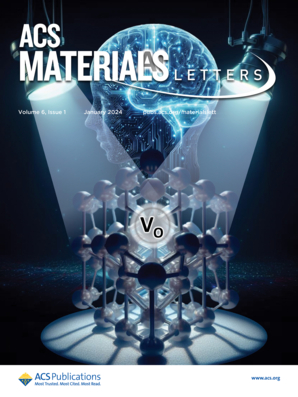用于热可编程催化的氧化铝-钛纳米层析冷凝器
IF 9.6
1区 化学
Q1 MATERIALS SCIENCE, MULTIDISCIPLINARY
引用次数: 0
摘要
利用原子层沉积技术,为碳化铂催化冷凝器设计了由 Al2O3 和 TiO2 薄交替层(ATO)组成的纳米层压材料作为介电材料。研究评估了合成参数,包括沉积温度、Al2O3 和 TiO2 层厚度、层总数以及 Al2O3 盖层对铂催化剂中最大电荷积累的影响。最高电容 ATO 配置的比电容为 1200 nF/cm2,工作电压为 ±5 V,室温下每平方厘米可存储 4 × 1013 个电子或空穴。ATO 器件在高达 400 °C 的高温下显示出更强的电容,表明这些材料适合高温应用。通过掠入射红外光谱对一氧化碳在 Pt/C-ATO 器件上的吸附进行表征,结果表明,在施加 ±1 V 的外部电压偏置时,表面结合能的变化为 13.1 ± 0.8 kJ/mol。本文章由计算机程序翻译,如有差异,请以英文原文为准。

Alumina–Titania Nanolaminate Condensers for Hot Programmable Catalysis
Nanolaminates composed of thin alternating layers of Al2O3 and TiO2 (ATO) were engineered by using atomic layer deposition as the dielectric material for a Pt-on-carbon catalytic condenser. Investigation assessed synthesis parameters including the deposition temperature, Al2O3 and TiO2 layer thicknesses, total number of layers, and a capping Al2O3 layer on the maximum charge accumulation in the Pt catalyst. The highest capacitance ATO configuration demonstrated a specific capacitance of ∼1200 nF/cm2 with working voltages of ±5 V, enabling the storage of 4 × 1013 electrons or holes per cm2 at room temperature. The ATO devices exhibited enhanced capacitance at elevated temperatures of up to 400 °C, suggesting the suitability of these materials for high-temperature applications. Adsorption of carbon monoxide on the Pt/C-ATO device characterized by grazing incidence infrared spectroscopy showed changes in the surface binding energy of 13.1 ± 0.8 kJ/mol for an applied external voltage bias of ±1 V.
求助全文
通过发布文献求助,成功后即可免费获取论文全文。
去求助
来源期刊

ACS Materials Letters
MATERIALS SCIENCE, MULTIDISCIPLINARY-
CiteScore
14.60
自引率
3.50%
发文量
261
期刊介绍:
ACS Materials Letters is a journal that publishes high-quality and urgent papers at the forefront of fundamental and applied research in the field of materials science. It aims to bridge the gap between materials and other disciplines such as chemistry, engineering, and biology. The journal encourages multidisciplinary and innovative research that addresses global challenges. Papers submitted to ACS Materials Letters should clearly demonstrate the need for rapid disclosure of key results. The journal is interested in various areas including the design, synthesis, characterization, and evaluation of emerging materials, understanding the relationships between structure, property, and performance, as well as developing materials for applications in energy, environment, biomedical, electronics, and catalysis. The journal has a 2-year impact factor of 11.4 and is dedicated to publishing transformative materials research with fast processing times. The editors and staff of ACS Materials Letters actively participate in major scientific conferences and engage closely with readers and authors. The journal also maintains an active presence on social media to provide authors with greater visibility.
 求助内容:
求助内容: 应助结果提醒方式:
应助结果提醒方式:


